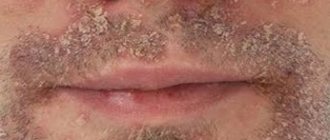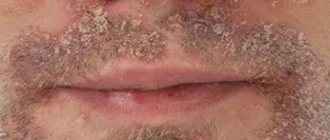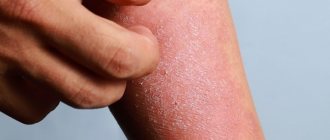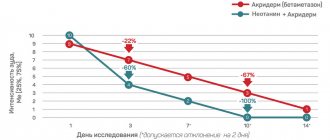Of all known skin diseases, atopic dermatitis is the most insidious. It is quite difficult to identify it, make an accurate diagnosis and treat it. The signs of atopic dermatitis, as a rule, do not differ from the symptoms characteristic of other skin pathologies, but they have some features. Often people do not even realize that they are sick; they try to cure skin irritation with ordinary cosmetics and folk remedies. Sometimes the symptoms go away, but after some time atopic dermatitis appears again with a number of complications. To avoid this, it is necessary to recognize dermatitis in time and understand the causes and mechanism of its development.
Causes of development of atypical dermatitis
Atopic dermatitis is an inflammatory, chronically relapsing pathology of the skin, accompanied by constant itching, as well as eczematous and lichenoid rashes. The disease is also called allergic eczema, as it very often occurs at the same time as:
- bronchial asthma;
- food allergies;
- allergic rhinitis;
- conjunctivitis;
- ichthyosis. [12]
Atopic dermatitis most often develops in childhood - the prevalence among children reaches 15-30%; in 9 out of 10 cases it develops in the first year of life. The incidence in adults is 2-10%. Women suffer from it more often than men. Most cases occur in cities with high levels of pollution and cold climates. [3]
This is an immune-dependent pathology. The reasons for its development are associated with mutations in genes that are responsible for the synthesis of filaggrin, a structural skin protein involved in the formation of the stratum corneum, which, in turn, is responsible for the barrier functions of the skin. Like a brick wall, the stratum corneum of the epidermis retains water and does not allow a large number of allergens and microorganisms to enter the body. In patients with dermatitis, the synthesis of filaggrin is impaired, and the connections between the cells of the stratum corneum are damaged. Because of this, the skin retains moisture worse and is more sensitive to any external influences. The mechanism is as follows: the pathogen enters the body through damaged skin, and the immune system produces immunoglobulins. Against the background of these processes, symptoms of atopic dermatitis arise. [4]
Scalp dermatitis: problems in the endocrine system and hormonal levels
Changes in the functioning of the hormonal system do not always benefit the body.
In this case, they are expressed in increased proliferation of the fungus.
This phenomenon is due to the fact that it is sex hormones that control the secretion of the sebaceous glands.
Steroids have the greatest effect.
It was found that in women diagnosed with seborrheic dermatitis (eczema) of the epidermis or scalp, the concentration and ratio of testosterone and estrogen are impaired.
Laboratory analysis indicated increased testosterone levels with a simultaneous decrease in estrogen.
A change in the level of androgens in the body, namely their increase, can act as a hereditary disease or be a sign of some pathology.
Diseases that can occur with increased androgen levels:
- congenital adrenal dysfunction
- Stein-Leventhal syndrome
- androsteroma (hormonally active tumor localized in the adrenal gland)
- testicular cancer
- hypercortisolism syndrome
Dermatitis of the scalp is often observed during adolescence in a child.
This is also due to natural hormonal changes.
In female patients, dermatitis more often manifests itself against the background of the onset of menstruation or diseases of the urogenital tract.
Scalp dermatitis: diseases of the central nervous system and autonomic system
In addition to the hormonal background, the nervous system and the autonomic system take part in the secretion of the sebaceous glands.
Thus, many patients with chronic pathologies, for example, excessive sweating or hypotension, experience increased sebum production.
This also applies to the central nervous system; it also takes part in the process of sebum secretion.
A large number of patients with pathologies of the nervous system (neurasthenia, neuroinfections, chronic depression, etc.) show signs of dermatitis.
Diseases that are most often accompanied by increased sebum production:
- parasympathicotonia
- shaking palsy
- encephalitis Economo
- epileptic disorder.
Factors provoking the disease
A genetic mutation does not cause atopic dermatitis on its own. The disease develops under the influence of provoking factors. Most often these are atopenes - allergens to which the immune system produces antibodies. These include:
- food allergens - cow's milk, wheat, crayfish, crab, soy, chocolate, citrus fruits;
- pollen atopenes – wormwood, ragweed;
- dust pathogens - animal hair, dust, bed mites, molds. [5]
Some foods (smoked meats, sweets, hot spices, alcoholic drinks), medications (antibiotics, vitamins, sulfonamides) and cosmetics (perfumes, decorative cosmetics) can also lead to the development of atopic dermatitis in children and adults.
Factors due to which a person can develop dermatitis are divided into external and internal. Some of the external factors have already been mentioned, but they also include:
- climatic conditions;
- evaporation of solvents such as turpentine and acetone;
- harmful working conditions;
- environmental pollution with smoke and toxic fumes of aggressive substances. [5]
Internal factors are associated with other diseases of the gastrointestinal tract and endocrine system, as well as viral infections.
Many scientists believe that severe emotional stress and hormonal changes are also risk factors for developing atopic dermatitis. [6]
Symptoms of atopic dermatitis
Depending on the age of patients with dermatitis, the symptoms of the disease can be very different. There are three phases of atopic dermatitis:
- infant - from 7-8 weeks to 1.5-2 years;
- children's - from 2 to 12-13 years;
- adults - from the onset of puberty and older. [6, 7]
Beginning in infancy, atopic dermatitis lasts until puberty, and even until the end of life, often with remissions of varying duration. As a rule, symptoms are most pronounced in infancy and early childhood. In infants, the symptoms of atopic dermatitis include dry, scaly and itchy plaques that appear on the head, forehead and cheeks, and the outer elbows and knees. In children over 2 years of age, the manifestations are more extensive - rash and redness, dryness and flaking of the skin, as well as constant itching of the affected skin, which becomes rougher and thicker. In this case, atopic dermatitis affects the elbow and knee folds, wrists, ankles, neck, and buttock folds. An exacerbation of the disease is observed at the ages of 7-8 years and 12-14 years. [8]
As for symptoms in adulthood, we are talking specifically about episodic exacerbations of atopic dermatitis after many years of remission. They are characterized by:
- inflammation that starts from the elbow or knee folds, the back of the neck and spreads to the arms;
- pronounced dry skin with very severe peeling;
- incessant itching. [8]
Clinical manifestation of seborrhea on the head
The pathology is manifested by the formation of scaly crusts resembling dandruff.
However, the disease should not be confused with regular dandruff, which is usually dry, fine and white in color.
Dandruff, typical of seborrheic dermatitis, is yellowish in color and feels greasy to the touch.
As seborrheic dermatitis of the scalp worsens, other symptoms of the pathological process appear.
This is pronounced peeling, due to the active rejection of epidermal cells, itching, and discomfort.
The surface layer of the skin epithelium consists of horny plates.
They are characterized by gradual rejection and replacement of the old epidermis with a new one.
With dermatitis, this process develops excessively, which is accompanied by severe peeling, itching, and redness.
Sometimes massive inflammatory foci appear, which are aggravated by frequent scratches.
Seborrheic dermatitis can spread to several areas of the skin, affecting the forehead and back of the head.
Seborrheic dermatitis is relatively easy to identify; a dermatologist can make a preliminary diagnosis after the first examination.
The characteristic yellowish dandruff and affected areas allow in most cases to quickly diagnose the disease.
It has been found that in many patients, the symptoms of dermatitis worsen during the winter.
Increased UV radiation in summer interferes with the cell division of the yeast Malassezia furfur.
As a result, the disease in the summer is alleviated.
Separately, it is worth noting the course of seborrheic dermatitis of the scalp in infants.
Here it is important to differentiate pathology from other, more serious diseases.
Thus, in children, the pathology is often similar to the manifestation of Letterer-Sive syndrome, which is accompanied by the formation of crusts and scales on the head.
In addition, Wiskott-Aldrich disease has a similar clinical picture.
Diagnosis of skin pathology
At the moment, there is no specific laboratory test that can detect atopic dermatitis. The diagnosis is made based on the symptoms present and an assessment of the severity of the disease. The severity of atopic dermatitis is determined using the SCORAD scale, which includes a number of objective and subjective criteria. The first includes the strength and prevalence of lesions, the subjective - the intensity of itching during the day and night. [9]
To establish atopic dermatitis, it is necessary to identify specific IgE antibodies to allergens. For this purpose, cutaneous patch tests are performed, but only if the patient has delayed-type hypersensitivity.
Atopic dermatitis is often confused with other diseases. To avoid mistakes, differential diagnosis is carried out using laboratory tests:
- detection of platelet pathology;
- determination of immune status;
- microscopy of scales. [9]
Sometimes, to distinguish atopic dermatitis from other pathologies, the localization of the rash is sufficient. So vulgar psoriasis affects the extensor surfaces, while the manifestations of atopic dermatitis are localized in the flexor areas.
What complications can there be?
If atopic dermatitis is not properly treated, the disease will develop and lead to complications. Like manifestations, the severity and severity of complications are directly related to the age of the patient. The infantile phase is characterized by complications of atopic dermatitis such as candidiasis and Kaposi's eczema herpetiformis. In childhood, staphylococcal impetigo, molluscum contagiosum and chronic papillomavirus infection are observed. Complications in the adult phase are represented by dermatophytosis and keratomycosis. [10]
Without treatment, atopic dermatitis can significantly reduce the quality of life of the patient and his family. Discomfort is primarily associated with a person’s appearance - with dermatitis, noticeable itchy spots appear on the body, which cause anxiety among others. And although atopic dermatitis cannot be contracted, people are wary of patients and do not want to come into contact with them. Patients experience a continuous desire to scratch the inflammation, so their posture and facial expression look tense and repulsive. Therefore, when it comes to dermatitis, one cannot fail to mention the neurotic and psychological syndromes that this disease entails.
What is atopy?
The content of the article
Atopy is an abnormal response of the body to an allergen, resulting in overproduction of IgE antibodies responsible for the allergic reaction. Atopic dermatitis belongs to the group of atopic diseases, like bronchial asthma, urticaria and hay fever.
Patients prone to atopy usually have several allergic diseases at the same time. The body of a person with AD responds to very low doses of allergen (molecules that can trigger an immune response) in the environment. The disease can be caused by many factors that surround us: dust mites, pollen from flowers, animals and food.
Treatment with Akriderm drugs
Akriderm preparations are products for the local treatment of manifestations of atopic dermatitis with a wide spectrum of action. Thanks to the combined composition, including a glucocorticosteroid, an antibiotic and an antifungal component, the products have several effects at once:
- anti-inflammatory;
- antiallergic;
- vasoconstrictor;
- antipruritic. [12]
Since atopic dermatitis can occur in both acute and chronic forms, Akriderm preparations are available in the form of ointments and creams. This allows you to choose the most appropriate remedy based on the course of the disease, the severity of manifestations and the presence of secondary infection. Active substances penetrate deeply into the source of inflammation, fighting not only pathogens that provoke atopic dermatitis. Treatment is also aimed at combating attached microorganisms. Thus, Akriderm preparations have a bacterial and antifungal effect. [13]
A well-thought-out formulation of the drugs makes it possible to use them in the treatment of atopic dermatitis in children over 2 years of age. [14, 15]. Other advantages of Akriderm preparations for the topical treatment of atopic dermatitis include:
- convenient release form – 15 g and 30 g;
- reasonable price - the cost of a 30 g package is more profitable for the buyer compared to 15 g of a similar product; [16]
- over-the-counter status, which makes Akriderm preparations one of the most accessible means for treating manifestations of dermatitis.
Diet
Diet is very important for the prevention of dermatitis and their treatment in both adults and children. Foods that provoke allergies should be excluded from the menu: citrus fruits, nuts, red fish, eggs, chocolate, honey. It is recommended to limit irritating foods as much as possible - spices, vinegar, salty, spicy and smoked foods. Patients are advised to take light soups, low-fat foods, and fermented milk products. It is necessary to drink enough water.
For infants suffering from atopic dermatitis, it is advisable to continue breastfeeding. At the same time, the mother should exclude allergens from her food as much as possible. If breastfeeding is not possible, the child is prescribed special formulas with a minimum content of cow's milk protein. Complementary feeding is introduced to such children as late as possible, with extreme caution. Each new product and the reaction to it should be recorded in a food diary.
Article sources:
- Characteristics of seborrheic dermatitis. Shukurov I.B., Yakhshieva M.F., Rustamov M.K. Scientific journal, 2018
- Atopic dermatitis of adults. Dvoryankova E., Denisova E., Piruzyan A., Korsunskaya I. Doctor No. 3, 2022. p. 9-13
- Maintenance pharmacotherapy for atopic dermatitis. Petrova I.V., Omarov N.N., Sargsyan M.S., Khamroeva S.A., Osmanova Z.S., Proshin S.N. Reviews on clinical pharmacology and drug therapy, 2022. p. 60-63










